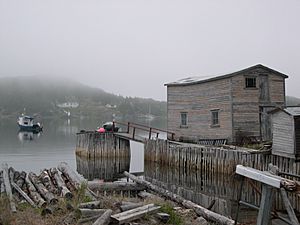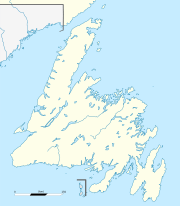Little Bay Islands facts for kids
Quick facts for kids
Little Bay Islands
|
|
|---|---|
|
Town
|
|

A dock in Little Bay Islands
|
|
| Country | |
| Province | |
| Population
(2020)
|
|
| • Total | 2 |
| Time zone | UTC-3:30 (Newfoundland Time) |
| • Summer (DST) | UTC-2:30 (Newfoundland Daylight) |
| Area code(s) | 709 |
Little Bay Islands is a unique place in Newfoundland and Labrador, Canada. It's known as a vacant town, which means almost everyone who used to live there has moved away. The community is made up of several small islands, including Little Bay Island, Macks Island, Goat Island, Harbour Island, and Boatswain Tickle Island. The tallest point is Campbell Hill, which is about 125 meters (410 feet) high. It's located in Notre Dame Bay, close to Springdale.
In 2019, most of the people living in Little Bay Islands decided to move as part of a special government program. This program helps small, remote communities that have become too expensive for the government to provide services to. While nearly all 55 residents left by the end of 2019, two people chose to stay. They now live "off the grid," using solar panels for power and wireless internet to stay connected.
A ferry called the MV Hazel McIsaac used to serve the island every day. But this service stopped on December 31, 2019. The two remaining residents even shared the ferry's final trip on Facebook Live.
A Look Back: History of the Islands
Little Bay Islands was first settled in 1825. It used to be a busy community with about 500 people. However, its population started to shrink a lot after the cod fishing moratorium. This happened when fishing for cod fish was stopped to protect the fish population.
By 2016, only about 71 people lived in the town. This number was much lower than in 2011. The community once had a school, a fire station, and two churches. The school closed in 2016, and one of the churches also closed before the relocation. The main source of jobs was a crab processing plant, but it closed in 2010. By 2018, there were only three paying jobs left, and most residents were retired.
The Relocation Program
The idea of moving the community had been discussed before, in 2011 and 2016. But the final vote for relocation finally passed in 2019.
The ferry service and electricity from the main power grid both ended on December 31, 2019. Only a couple, Georgina and Michael Parsons, decided to stay on the island all year round. Other former residents can still visit or live there in the summer. This is allowed because people can keep their homes even after getting money to move. However, they won't get any government services.
The government explained that the money given to property owners was not to buy their homes. Instead, it was to help them with the costs of moving. People who lived outside the community permanently did not need this financial help. In total, about $8.7 million was paid out. The government believes this relocation will save about $20 million over 20 years. A big part of these savings comes from no longer needing to run the ferry service. Since 2002, this relocation program has saved about $30 million for the province. There was an older program from 1954 to 1975 that helped about 28,000 people move from 300 remote places.
Georgina and Michael Parsons, the couple who stayed, told the news in 2019 that they were ready to live off the grid. They have a new home with a well for drinking water. They weren't allowed to vote on the relocation because they hadn't lived in the community long enough. The Parsons have a propane oven, wood stoves, satellite internet, and a solar panel system. They also have a snowmobile and boats to travel to the mainland for supplies. Michael Parsons said, "We look at it as an adventure. We’re looking forward to the solitude."
On December 31, 2019, the power to the islands was cut off at 2:30 p.m. The last ferry left the dock after 5 p.m. The Parsons even recorded this moment in a video.
Population Changes Over Time
| Historical populations | ||
|---|---|---|
| Year | Pop. | ±% |
| 1921 | 330 | — |
| 1945 | 550 | +66.7% |
| 1956 | 534 | −2.9% |
| 1961 | 426 | −20.2% |
| 1966 | 426 | +0.0% |
| 1971 | 394 | −7.5% |
| 1976 | 422 | +7.1% |
| 1981 | 407 | −3.6% |
| 1986 | 376 | −7.6% |
| 1991 | 260 | −30.9% |
| 1996 | 240 | −7.7% |
| 2001 | 175 | −27.1% |
| 2006 | 155 | −11.4% |
| 2011 | 100 | −35.5% |
| 2016 | 71 | −29.0% |
| 2021 | 0 | −100.0% |
| Source: Statistics Canada | ||
In the 2021 Census, Statistics Canada reported that Little Bay Islands had a population of 0. This was a big change from its 2016 population of 71 people. The island area is about 7.34 square kilometers (2.83 square miles).


